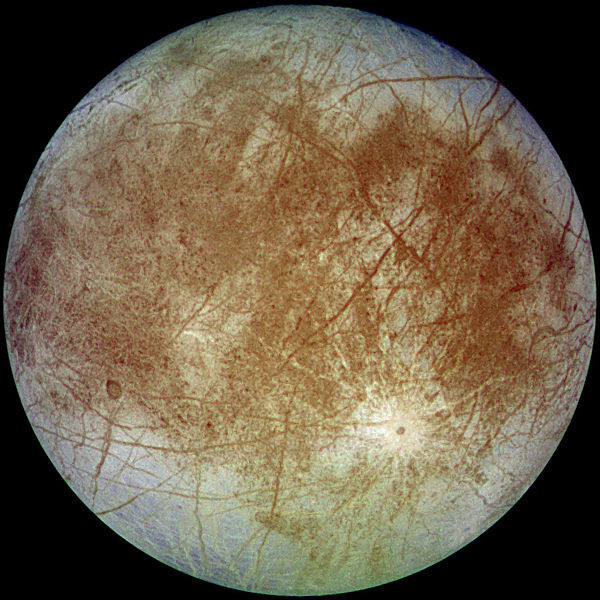Europa lander mission: Nasa plans to hunt for alien life on Jupiter's icy moon
Report sets out potential science value for sending a lander to Europa to look for past or present life.
Nasa is considering launching a mission to search for aliens on Europa. Jupiter's icy moon is currently considered one of the most likely objects in the solar system to harbour life, and Nasa has set out a report detailing the potential scientific value of sending a lander there in the near future.
"Europa may hold the clues to one of Nasa's long standing goals – to determine whether or not we are alone in the universe," the report said. "The highest-level science goal of the mission presented here is to search for evidence of life on Europa."
Scientists largely agree that Europa has a subsurface liquid ocean beneath its icy crust. This ocean is thought to be saline and in contact with the moon's rocky surface, providing conditions right for microbial life to exist.
The Nasa report, put together by the space agency's Planetary Science Division, outlines the scientific priorities of a lander mission to Europa, as well as the engineering required to complete it. After searching for aliens, other goals include assessing the moon's habitability and characterising the surface and subsurface for future robotic missions.
Should it go ahead, a Europa Lander would be the first Nasa mission primarily dedicated to the search for extraterrestrials since the Viking Mars spacecraft in the 1970s.
What would constitute signs of life on Europa?

From Nasa's Europa Lander Study 2016 Report
Science Goal #1 is to Search for Evidence of Life on Europa. No singular measurement would provide sufficient evidence for the detection of life on Europa; rather, the conclusion that evidence of life had been detected would require multiple lines of evidence, from different instruments, on a set of samples examined across a variety of spatial scales ... The model payload for the Europa Lander presents at least nine different and complementary possible lines of evidence for signs of life in samples collected on Europa.
These measurements range from detecting and characterizing organic compounds, to looking for cell-like structures, to determining if the samples originate from within Europa's ocean or other liquid water environments. The organic chemical analyses are specifically targeted to reveal the broadest possible range of signatures produced by life, including analysis of molecular type, abundance, and chirality.
Spectroscopic analyses of samples provide the inorganic and geochemical context of the samples, and enable discrimination between material native to Europa (endogenous) and materials that may have been externally delivered (exogenous, e.g., from micrometeorites), or processed by Europa's radiation environment.
Collection of five separate samples, each of at least 7 cc total volume, provides for repeated measurements, ensuring redundancy and robustness of results. Detection limits for measurements targeting evidence of life were established by comparison to several extreme, nutrient limited environments on Earth (Chapter 3). Importantly, the model payload and measurements defined for Goal 1 generate highly valuable scientific results even in the absence of any signs of life.
The report says any alien life will likely be in the form of microbial cells. This is based on our understanding of similar environments found on our own planet. "The science return possible from the model payload is such that if life is present in Europa's ice at a level comparable to one of the most extreme and desolate of environments on Earth (Lake Vostok ice) then this mission could detect life in Europa's icy surface," it said.
"The initial search for signs of life on Europa will largely take the form of a biochemical search ... Given that the availability of liquid water is likely not a limiting factor for life on Europa, the search for endogenous carbon-containing compounds becomes the critical next step in searching for biosignatures."
The three environments on Earth of most interest when considering life on Europa are deep polar oceans removed from sunlight, cold, deep brines and subglacial water environments. For example, deep oceans are cold, often covered in ice and energy limited, yet they are home to abundant microbial life.
"On and within Europa, life might concentrate at the interfaces, such as the seafloor or ice-water interface. Hydrothermal activity may power life, much as it does on Earth's seafloor, and oxidants within Europa's ice may help provide compounds to power life on Europa. Liquid water regions within the ice shell itself may also support life. Materials from the ocean could be entrained into Europa's ice shell or plumes, leading to potential biosignatures within the ice fractures, ice blocks and plume materials."
When could a mission take place?

Nasa is currently planning a flyby mission of Europa, expected to launch in the early 2020s. It will orbit Jupiter every two weeks, undertaking 45 close flybys of its moon. This will help scientists map its composition and work out the characteristics of its icy shell and subsurface ocean, providing a better understanding of its geology.
The space agency is now planning two meetings to discuss the Europa Lander report, during which it is hoping for feedback from the scientific community. These will take place on 19 March and 23 April. When the life-finding mission would take place is in part dependent on the outcomes of these meetings.
© Copyright IBTimes 2025. All rights reserved.






















